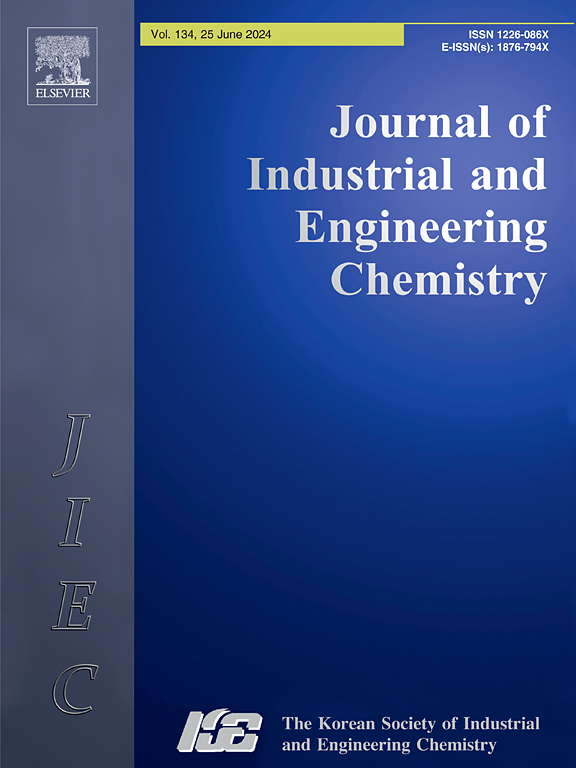Highly stable mesoporous Ni-phyllosilicate particle under high temperature hydrothermal and base conditions towards industrial catalytic applications
IF 5.9
3区 工程技术
Q1 CHEMISTRY, MULTIDISCIPLINARY
Journal of Industrial and Engineering Chemistry
Pub Date : 2025-01-25
DOI:10.1016/j.jiec.2024.07.013
引用次数: 0
Abstract
Two mesoporous nickel phyllosilicate (Ni-PS) samples with Ni/Si ratios of 0.3 and 1 were used to compare high-temperature hydrothermal stability. The Ni-PS structures have well-developed porosity and pore size distributions mainly ranging from 2 to 20 nm. To assess their hydrothermal resistance as a reusable heterogeneous catalyst in high-temperature reactions, the samples were exposed to 800 °C for 7 days using steam-supplied muffle furnaces. Three types of mesoporous silica samples (i.e. MCM-41, SBA-15, and mesoporous benzene-silica) and two zeolites (i.e. ZSM-5 and zeolite-Y) were compared under the same conditions. The hydrothermal resistance was primarily confirmed based on changes in pore size distribution and surface area through nitrogen-sorption isotherm analysis. The crystal structure and the binding energy of each sample were investigated by X-ray diffraction and X-ray photoelectron spectroscopy measurements. The Ni-PS structures displayed excellent stability (i.e. BET surface area retained over 77 % and 65 % after 1-d and 7-d treatment, respectively.) compared with other mesoporous samples, and even higher stability than zeolite Y. In addition, structural stability at pH = 10 is much higher than that of ZSM-5. This suggests that it could be used for various catalytic chemical reactions including hydrogenation and cracking processes because NiO and Ni nanoparticles are uniformly distributed on the surface, maintaining their particle shape even after a reduction process.

高温水热和碱液条件下的高稳定性介孔镍-斑硅酸盐颗粒的工业催化应用
采用Ni/Si比分别为0.3和1的两种介孔层状硅酸镍(Ni- ps)样品,比较高温水热稳定性。Ni-PS结构孔隙发育,孔径分布主要在2 ~ 20 nm之间。为了评估其作为高温反应中可重复使用的多相催化剂的水热抗性,样品在蒸汽供应的马弗炉中暴露于800°C 7天。在相同的条件下,比较了三种介孔二氧化硅样品(MCM-41、SBA-15和介孔苯-二氧化硅)和两种沸石(ZSM-5和沸石- y)。通过吸附氮等温线分析,主要通过孔径分布和比表面积的变化来确定热液阻力。通过x射线衍射和x射线光电子能谱测量研究了各样品的晶体结构和结合能。与其他介孔样品相比,Ni-PS结构表现出优异的稳定性(处理1 d和7 d后,BET表面积分别保持在77%和65%以上),甚至比y分子筛的稳定性更高,并且在pH = 10时的结构稳定性远高于ZSM-5。这表明它可以用于各种催化化学反应,包括加氢和裂化过程,因为NiO和Ni纳米颗粒均匀分布在表面,即使经过还原过程也能保持其颗粒形状。
本文章由计算机程序翻译,如有差异,请以英文原文为准。
求助全文
约1分钟内获得全文
求助全文
来源期刊
CiteScore
10.40
自引率
6.60%
发文量
639
审稿时长
29 days
期刊介绍:
Journal of Industrial and Engineering Chemistry is published monthly in English by the Korean Society of Industrial and Engineering Chemistry. JIEC brings together multidisciplinary interests in one journal and is to disseminate information on all aspects of research and development in industrial and engineering chemistry. Contributions in the form of research articles, short communications, notes and reviews are considered for publication. The editors welcome original contributions that have not been and are not to be published elsewhere. Instruction to authors and a manuscript submissions form are printed at the end of each issue. Bulk reprints of individual articles can be ordered. This publication is partially supported by Korea Research Foundation and the Korean Federation of Science and Technology Societies.

 求助内容:
求助内容: 应助结果提醒方式:
应助结果提醒方式:


